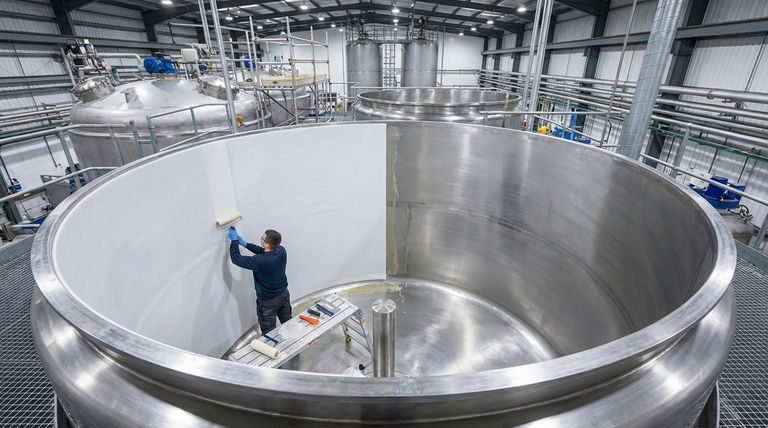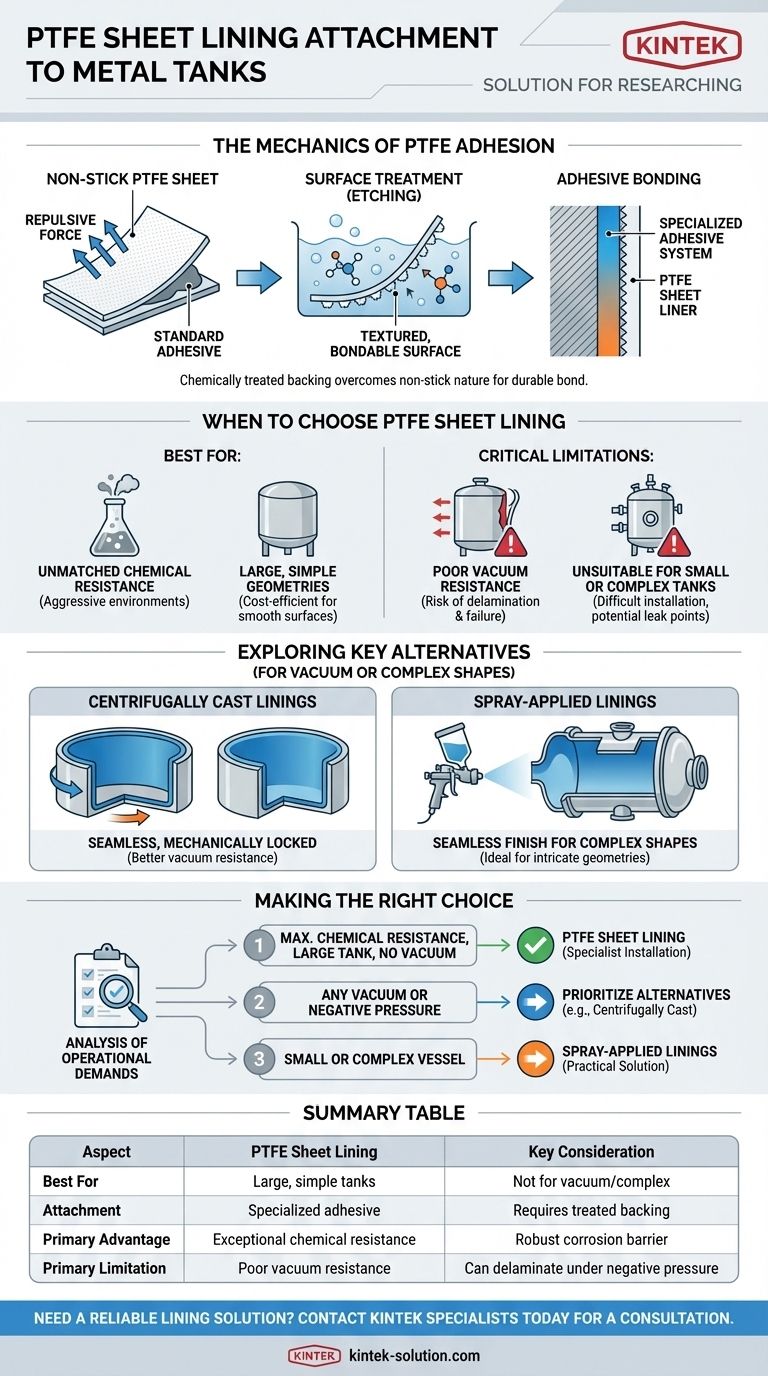In short, PTFE sheets are bonded to metal tanks using specialized adhesives. This process is only possible because the backing of the PTFE sheet is chemically treated to create a bondable surface, overcoming PTFE's inherent non-stick nature.
The method of attachment—adhesive bonding—is straightforward, but the success of a PTFE sheet lining depends entirely on understanding its specific limitations. It is a specialized solution that is not suitable for all applications, particularly those involving vacuum pressure or small, complex tank geometries.

The Mechanics of PTFE Adhesion
Attaching a material famous for being non-stick requires a very specific approach. The process is less about the adhesive itself and more about preparing the PTFE to accept that adhesive.
The Challenge of Bonding to PTFE
Polytetrafluoroethylene (PTFE) has extremely low surface energy. This is what gives it its characteristic non-stick, low-friction properties. It also means that standard adhesives have nothing to "grip," causing them to peel away easily.
The Critical Role of Surface Treatment
To solve this, the back of the PTFE sheet undergoes a chemical treatment process, often called etching. This process alters the molecular structure of the PTFE surface, creating a texture that is receptive to bonding with an adhesive.
The Adhesive System
Once the PTFE sheet is treated, a specialized, high-performance adhesive system is used. This adhesive is formulated to create a durable, chemically resistant bond between the prepared PTFE backing and the properly prepared metal surface of the tank.
When to Choose PTFE Sheet Lining
PTFE sheet lining is an excellent choice for specific scenarios but is not a universal solution. Its strengths lie in its material properties when applied in the right environment.
Unmatched Chemical Resistance
The primary reason to select a PTFE lining is for its exceptional resistance to a wide range of aggressive chemicals, even at high temperatures. It provides a robust barrier in highly corrosive environments.
Ideal for Large, Simple Geometries
This method is most effective and cost-efficient when lining large tanks with smooth, simple internal surfaces. Applying large, flat sheets is more practical than attempting to fit them into complex shapes.
Understanding the Trade-offs and Limitations
Objectively, the limitations of PTFE sheet lining are as important as its benefits. Ignoring them is a common cause of failure.
Limited Vacuum Resistance
This is the most critical drawback. PTFE sheet linings have poor resistance to vacuum (negative pressure). A vacuum inside the tank can easily pull the liner away from the metal wall, causing bubbles, delamination, and catastrophic failure.
Unsuitability for Small or Complex Tanks
Lining small tanks or vessels with intricate nozzle configurations and internal structures is extremely difficult and impractical with rigid sheets. The number of seams required introduces potential points of failure.
The Need for Specialization
Applying a PTFE sheet lining is not a general fabrication task. It must be performed by specialized companies with experience in surface preparation, etching, and bonding techniques to ensure a successful and long-lasting application.
Exploring Key Alternatives
If your application involves vacuum pressure or complex shapes, other lining technologies are superior.
Centrifugally Cast Linings
In this process, a polymer is rotationally cast inside the vessel, creating a thick, seamless lining that is mechanically locked into place. This method offers far better vacuum resistance than bonded sheets.
Spray-Applied Linings
High-performance fluoropolymer coatings can be sprayed onto the interior of a tank. This method creates a seamless finish and is ideal for lining small or geometrically complex vessels that are unsuitable for sheet lining.
Making the Right Choice for Your Application
Selecting the correct lining technology requires a clear analysis of your operational demands, not just the chemical environment.
- If your primary focus is maximum chemical resistance in a large tank with no vacuum conditions: PTFE sheet lining is a strong and appropriate choice, provided it is installed by specialists.
- If your application involves any level of vacuum or negative pressure: You must prioritize alternatives like centrifugally cast or other mechanically robust lining systems.
- If you need to line a small or geometrically complex vessel: Spray-applied linings are almost always the more practical and reliable solution.
Ultimately, matching the lining technology to the specific mechanical and chemical stresses of your process is the key to ensuring long-term tank integrity.
Summary Table:
| Aspect | PTFE Sheet Lining | Key Consideration |
|---|---|---|
| Best For | Large, simple tanks with aggressive chemicals | Not suitable for vacuum or complex geometries |
| Attachment Method | Specialized adhesive bonding | Requires chemically treated PTFE backing |
| Primary Advantage | Exceptional chemical resistance | Provides a robust barrier against corrosion |
| Primary Limitation | Poor vacuum resistance | Can delaminate under negative pressure |
Need a reliable lining solution for your chemical process tank?
At KINTEK, we specialize in manufacturing high-precision PTFE components, including custom-fabricated liners for the semiconductor, medical, laboratory, and industrial sectors. Our expertise ensures your tank lining is matched perfectly to your application's chemical and mechanical demands, from prototype to high-volume production.
Contact our specialists today for a consultation on your specific requirements.
Visual Guide

Related Products
- Custom PTFE Parts Manufacturer for Teflon Parts and PTFE Tweezers
- Custom PTFE Parts Manufacturer for Teflon Containers and Components
- Custom PTFE Square Trays for Industrial and Laboratory Use
- Custom PTFE Sleeves and Hollow Rods for Advanced Applications
- Custom PTFE Measuring Cylinders for Advanced Scientific and Industrial Applications
People Also Ask
- What fabrication services are available for PTFE? Shearing, Stamping, Laser Cutting, Molding & Machining
- What are the main applications of PTFE type Teflon? Unlock Its Versatility for Your Industry
- What factors should be considered when choosing between Nylon and PTFE? Select the Right Material for Your Application
- What design considerations are important for custom PTFE parts? Design for Performance & Reliability
- What industrial benefits do PTFE-machined parts offer? Achieve Peak Performance in Demanding Applications



















